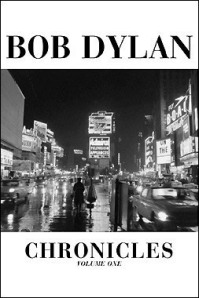My opinions of Bob Dylan have always been conflicted… I have always enjoyed his early recordings but have been mystified by his post-1970 output. As I have aged, I have come to understand the extremely important role he holds in popular music and American culture. This realization has brought me to put more effort into understanding his music and the easiest way for me to interface better with an artist’s output is with hearing the story behind it. After researching the myriad of book options available on the life of Bob Dylan, I’ve decided to start with the one written by the man himself.
Dylan’s writing is powerful, yet still conversational. Throughout the book I felt as if I was chatting with him over dinner. His tone is of someone who is reluctantly, sometimes self-possessedly, getting things off his chest. The book was not as structured as I had expected… but having known something of his past, as everyone does, I should have expected the books structure would be a bit abstract. My main surprise was that he jumps around his life, each chapter a different time period which is not clearly defined. I, like many fans, were hoping for Volume One to chronicle his life before fame and his early career much like Martin Scorsese’s film No Direction Home.
The book is broken up into 5 parts. Here is a guide to give you an idea of exactly what periods he covers.
1. Making up the Score (takes place in 1961 soon after signing on with John Hammond)
2. The Lost Land (continues the narrative from the previous chapter with more scenes from 1961 and flashes of his upbringing)
3. New Morning (focuses on the recording of the album of same name – recorded 1970)
4. Oh Mercy (focuses on the writing and recording of the album of the same name – 1987-89)
5. River of Ice (takes place in 1962 right after making his first Demos with Lou Levy of Leeds Music with more flashbacks)
It seems like years pass while Dylan is telling his story, and in some ways, they do as he gets sidetracked and gives little glimpses of his upbringing or his pre-NY life. The highlights there are info on his upbringing in Hibbing MN, his brief stop-off in Minneapolis/ Dinky Town before he took the train to New York City. He also touches upon his experiences in early Rock N’ Roll bands which give you a little more insight into his musical influences. Those portions were of most interest to me as I have first-hand knowledge of that geography, being from Minnesota myself. Mainly though, he is engaged in telling the story of when he first arrived in New York or, in the case of chapters 2 & 3, what happened during the recording of two of his post-1960’s. Dylan gives little info on his family members, probably out of respect for his and their privacy. He doesn’t really talk much about his parents and only mentions his wife in passing. Only 4-5 years of his life are covered in the book (plus bits and pieces of his pre-NY life.) Some of my favorite parts of the book are when Dylan makes references to things or events that are more recent. For example he, at one point, references the classic Dylan book Invisible Republic by music writer Greil Marcus… Or when he tells the story of his failed attempt to retrieve Woody Guthrie’s unused song lyrics and he goes on to (almost bitterly) report that those lyrics were used 37 years later by Billy Bragg & Wilco for Mermaid Avenue Volumes 1 & 2.
What is left is a tremendous amount of ground for him to cover and, considering this is supposed to be a 3 part series. As a reader, I worry that he won’t finish it or at least get to the most interesting bits.
It’s obvious that Dylan is a great artist, on par with the great painters or classical composers. In fact he seems at times to be the complete embodiment of the archetype. He is a man that is extremely creative, self-absorbed to a fault, 100% left brain. I found myself wondering if he had been born in a different time if he would have been diagnosed with ADD or ADHD, considering his behavior at times. He even seems to portray himself as quite the narcissist, but then again what artist or musician isn’t at least a bit of one? One of the things that struck me about Dylan was the shear amount of powerful cultural figures he crossed paths with, so much so he almost seems like a magnet for brilliant people.
In the end I was left a little disappointed. Although the book is enjoyable it doesn’t even scratch the surface of what Dylan has to offer. If you have a curiosity for this fellow I would suggest reading a biography (not an auto-)… although I do not have a specific one to suggest. Beyond that is the wonderful documentary I mentioned before, directed by Martin Scorsese. In the end though, even that cuts off a little abruptly and doesn’t cover him past his late 60’s material.
A wonderful audio accompaniment to this book (for at least the NYC chapters) is The Bootleg Series, Vol. 9: The Witmark Demos: 1962-1964 (buy it /listen to it) that Columbia Records released last year. Consuming them together is an ideal way to do it but alone it sheds a lot of light on the kind of material he built his style on… mainly a lot of old folk and blues songs.
